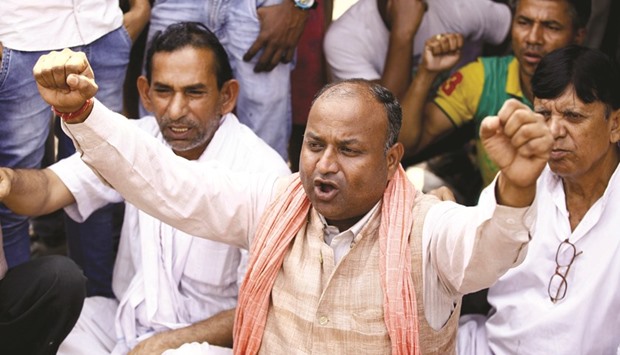An ailing Sadbhawana Party president Rajendra Mahto yesterday stoutly denied that the Madhesi Morcha, an alliance of four parties of Nepal’s Terai region demanding amendment to the country’s statute, has split.
Mahto’s assertion came in the wake of media reports from Kathmandu that the Samyukta Loktantrik Madhesi Morcha, spearheading the over four-month-old protest, had split with Mahto opting for continuing the agitation separately.
Speaking from his hospital bed in Medanta, in Gurgaon, near New Delhi, where he is recovering from injuries received in a clash with the police at Biratnagar on December 26, Mahto said: “The Madhesi Morcha remains united and shall continue the struggle which it has been waging for the past more than four months.”
“Our struggle is historic and we shall achieve our goal... We are prepared to carry on our agitation for as long as it takes to secure our genuine demands....”
Mahto reiterated the resolve that the planned agitation programme would be carried forward and denied that there was any change advised by him therein as reported in the Nepali media.
According to media reports from Kathmandu, the Sadbhawana Party was reported to have announced that it will focus on non-violent activities like mass prayers in memory of deceased protestors, fasting, signature campaign and campaigns to internationalise the Madhesi
issue through social media.
Mahto said these activities were proposed by him to Madhesi protesters from his hospital bed in the B P Koirala Institute of Health Sciences at Dharan where he had been admitted for treatment of his injuries following the December 26 incident. “This was meant as an activity aimed at lending a peaceful touch to our agitation...”
For more than four months, the plains of the Nepal Terai have been simmering with Morcha-led protests against the country’s new constitution that was adopted by the constituent assembly on September 20.
The Morcha has expressed dissatisfaction over the content of the new constitution, including demarcation of the federal units, and called for an inclusive constitution and citizenship.
Along with Mahto’s Sadbhawana Party, the other constituents of the Madhesi Morcha are: the Terai Madhes Loktantrik Party with Mahanta Thakur as president; the Federal Socialist Forum-Nepal headed by Upendra Yadav; and the Terai Madhes Loktantrik Party-Nepal headed by Mahendra Yadav.
Over 55 people, including agitators and police personnel, have been killed during the four months of the Madhesi
agitation.
Nepal’s Terai region stretches from the Mechi river in the east to the Mahakali river in the west and comprises Madhes in its eastern part and the tribal-dominated Tharuhat in the western region. It has traditionally suffered immense discrimination from the Kathmandu-centric ruling elite that predominantly comprises the Brahmins (Bahuns) and Chhetris of the Nepal hills.
The major agitation demand is for the formation of two provinces in the Nepali Terai - the Madhes extending from the Mechi river in the east to the Narayani river in mid-western Nepal and Tharuhat pradesh from the Narayani to the Mahakali river in the west.
The Madhesi protesters are demanding, among others, a redrawing of the boundaries of the provinces in the Himalayan nation as proposed in the new Constitution; and restoration of rights granted to Madhesis in the interim constitution of 2007 which the new charter has snatched away.
They also want representation in parliament on the basis of population - the Nepal Terai has almost 51% of the country’s population yet gets only one-third of seats in parliament - and proportional representation in government jobs.

A Madheshi leader shouts slogans during a protest at the Miteri bridge on India-Nepal border. Nepal’s southern plain has turned into a battleground as the ongoing protests by the disgruntled ethnic minority have crippled everyday life.
